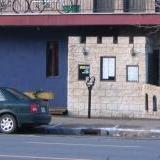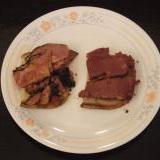Food Rating:  Value Rating:
Value Rating: 
 191 Jean-Talon Street East in Montreal - walk West towards St-Laurent from the Jean-Talon metro station. Phone: +1-514-270-9361.
191 Jean-Talon Street East in Montreal - walk West towards St-Laurent from the Jean-Talon metro station. Phone: +1-514-270-9361.
Open Tue-Sat for lunch and dinner.
2013: Le Petit Alep Official Website is now online with details and the whole menu.
Great food and excellent ambiance in the converted garage that houses this cafe.
Syrian/Armenian food.
Filet-mignon with a special spicy sauce - Chiche Kebab Terbialy. Absolutely the best, this is always a safe choice.
Pureed eggplant, tahini, garlic, lemon - Métabal.
Chicken in tahini - Poulet Trator.
Grilled Pita sandwich - Pitas grillés poulet. Chicken, mayo, garlic, with a nice kick - hint of spicy red-pepper?
For pictures, including a picture of the menu, visit the travel gallery Le Petit Alep in the Montreal album section.
The terbialy sauce is a nice, medium-to-hot spicy sauce,
and it makes the difference, best on the beef kababs (medium-rare), but also available with shrimp.
And then there are the weekday daily lunch specials with great soups -- just remember to get there during lunch Tuesday through Friday.
Kebbe Labanie (Kibbe Lebanese) - large meatballs in yogurt, garlic, mint sauce.
As they describe it: "boulettes de bœuf, blé concassé, noix, souce yogourt, ail, menthe".
Filet de sole Amandine
Soupe Harira - tomatoes, beef, fennel, cardamom - nice spicy soup.

